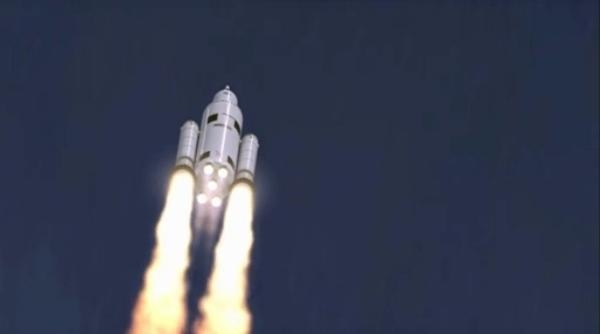Thu, Mar 15, 2012
Will Assist In Development Of Full-Scale SLS Motors
A sub-scale solid rocket motor designed to mimic NASA's Space Launch System, or SLS, booster design successfully was tested Wednesday by engineers at NASA's Marshall Space Flight Center in Huntsville, AL. The 20-second firing tested new insulation materials on the 24-inch-diameter, 109-inch-long motor. The motor is a scaled down, low-cost replica of the solid rocket motors that will boost SLS off the launch pad.

The test will help engineers develop and evaluate analytical models and skills to assess future full-scale SLS solid rocket motor tests. The next full-scale test, Qualification Motor-1 (QM-1), is targeted for spring 2013. Two five-segment solid rocket motors, the world's largest at 154-foot-long and 12-foot diameter, will be used in the first two 70-metric-ton capability flights of SLS. Previous ground tests of the motors included carbon insulation to protect the rocket's nozzle from the harsh environment and 5000-degree temperatures to which it is exposed. QM-1 will include a new insulation material, provided by a new vendor, to line the motor's nozzle.
"Test firing small motors at Marshall provides a quick, affordable and effective way to evaluate the new nozzle liner's performance," said Scott Ringel, an engineer at Marshall and the design lead for this test. "We have sophisticated analytic and computer modeling tools that tell us whether the new nozzle insulation will perform well, but nothing gives us better confidence than a hot-fire test."

The test also includes several secondary objectives. The team introduced an intentional defect in the propellant with a tool designed to create a specific flaw size. By measuring the temperature inside the motor at the flaw location, the team hopes to gain a better understanding for the propellant's margin for error. Test data also will help the team better understand acoustics and vibrations resulting from the rocket motor's plume. In addition, NASA's Engineering and Safety Center will use test data to measure a solid rocket motor's plume and how it reacts to certain materials.
More News
He Attempted To Restart The Engine Three Times. On The Third Restart Attempt, He Noticed That Flames Were Coming Out From The Right Wing Near The Fuel Cap Analysis: The pilot repor>[...]
Make Sure You NEVER Miss A New Story From Aero-News Network Do you ever feel like you never see posts from a certain person or page on Facebook or Instagram? Here’s how you c>[...]
From 2009 (YouTube Edition): Leading Air Show Performers Give Their Best Advice for Newcomers On December 6th through December 9th, the Paris Las Vegas Hotel hosted over 1,500 air >[...]
Aero Linx: NASA ASRS ASRS captures confidential reports, analyzes the resulting aviation safety data, and disseminates vital information to the aviation community. The ASRS is an i>[...]
“For our inaugural Pylon Racing Seminar in Roswell, we were thrilled to certify 60 pilots across our six closed-course pylon race classes. Not only did this year’s PRS >[...]
 NTSB Final Report: Rutan Long-EZ
NTSB Final Report: Rutan Long-EZ ANN FAQ: Turn On Post Notifications
ANN FAQ: Turn On Post Notifications Classic Aero-TV: ICAS Perspectives - Advice for New Air Show Performers
Classic Aero-TV: ICAS Perspectives - Advice for New Air Show Performers ANN's Daily Aero-Linx (06.28.25)
ANN's Daily Aero-Linx (06.28.25) Aero-News: Quote of the Day (06.28.25)
Aero-News: Quote of the Day (06.28.25)




